Bitcoin’s $140K Target Still in Play for 2025—But Brace for a 2026 Bloodbath: Elliott Wave Analyst Warns
Bitcoin’s bull run isn’t dead yet—but the hangover could be brutal.
According to Elliott Wave theory, BTC remains on track to hit $140K by year-end. The catch? A punishing correction looms in 2026, threatening to wipe out weak hands.
Timing the top? Good luck—Wall Street’s crystal balls have a worse track record than a blindfolded dart thrower.
What is the Elliott Wave?
The Elliott Wave Theory, introduced by Ralph Nelson Elliott in 1938 in his book, "The Wave Principle, is a way of understanding market movements by recognizing that they follow predictable, repeating patterns like natural fractals.
The Core idea is that crowd psychology moves in cycles, creating a pattern of five waves in the direction of the primary trend or the impulse move. The five-wave structure encompasses three impulse waves (1,3, and 5) and two retracing waves (2 and 4). Sometimes, impulse waves are extended and powerful, comprising their own 5-wave structure.
A three-wave corrective structure follows the five-wave structure. This 5-3 wave pattern repeats at both larger and smaller scales, allowing observers to forecast future price action based on the market's current position within the broader context.

According to the above chart, BTC is currently moving in the impulse wave (iii) of the extended impulse wave 5.
The impulse wave (iii) could hit a high of $130,000 in the next couple of weeks, before prices drop to around $110,000 in September, completing the retrace wave (iv). After that, the final impulse wave (v) of the larger impulse wave 5 will resume, marking a bull market peak at around $140,000.
"Once we achieve the $140,000-ish region, there will be a LOT of debate as to how much further the market will go, and I'm sure we'll hear the bulls quoting $250,000 to $500,000 in 2026. This is not my thesis as I believe we will enter a bear market for BTC in 2026," Glover said.
Glover's take contrasts with the popular narrative that institutional adoption through ETFs has broken bitcoin's four-year cycles, which historically indicate a price peak this year followed by an extended bear market.

